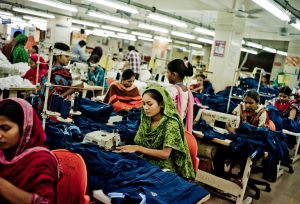-Dana Chan ’19
#OOTD or “Outfit of the Day” has been trending on social media, where anyone can snap a photo of their look and share it with their friends and followers. It has been a way for people to communicate about their favorite places to shop – be it boutiques, luxury brands or fast fashion retailers. But what is the true cost of this obsession with OOTDs and buy-in to fast fashion? Let’s start by taking a look at the industry.

Photo: Lance Lee
Fast Fashion refers to the phenomenon wherein clothing is produced, sold and discarded at an accelerated pace. Whereas fashion traditionally has two seasons – Spring/Summer and Fall/Winter, the fast fashion industry releases as many as 52 “micro-seasons” each year. Fast Fashion evolved to make consumers want to spend more on clothing to keep up with new styles being released almost every week. With summer just around the corner, many of us will start looking at our favorite clothing chains and online stores for the latest summer fad, either as a way to express our personal style or to show that we’re up to date with what’s popular this season.
A trademark of fast fashion is that the latest fashion trend becomes available at a relatively inexpensive price, making it appealing to students like us. While $8 for that cute dress seems like a good deal, it’s important to remember that we are also shouldering the environmental and human consequences of that price tag.
Plants grown for fiber are doused with pesticides to ensure a good yield. These chemicals are essentially poisons that regularly seep into bodies of water that local communities heavily rely on. Most toxic chemicals remain and build up in the waterways to the point that rivers and lakes become too harmful for human use and almost always cause a wide range of health problems for the local population. Additionally, the majority of the manufacturing is done in factories overseas where environmental regulations are looser, contributing to widespread water and air pollution. All of these are done for the sake of cheap, poorly made clothing that, in many cases, end up in landfills after only a few wears. [Source, Source]

Photo: Tomas Munita
While it might be easy to ignore the environmental impacts of this industry, imagine if you were face-to-face with the worker who made your clothes. Many factory workers in developing countries work continuously for long hours on a small, non-livable wage. Most of them barely earn $1 each day, and they often work in harmful and unsafe conditions. The reason retailers can sell clothes at such a low price is because they cut corners on health and safety regulations, resulting in accidents that cost the lives of many of their garment workers. [Source, Source]
As an alternative, there are sustainable brands such as Patagonia, Alternative Apparel, and PACT, who are doing business in an environmentally and socially responsible way. Because these brands make concrete efforts to reduce their footprint and support their workers in a safe and fair way, prices are higher and most likely beyond what an average consumer can afford. Hence, we are in this dilemma where we do want to veer towards more sustainable fashion choices but at the same time, our financial situation prevents us from making that shift.
Being a more responsible consumer does not mean we have to sacrifice our wallets. We can think of sustainable brands as an investment and while they may be pricier, their clothing will most likely last longer. It might be a good idea to shop from sustainable brands for wardrobe staples and basics that we know we will use for a long time. Additionally, we can also look for accessories and trendy pieces from thrift shops and used clothing stores where many brand name clothing and vintage finds are sold at a discounted price. Nowadays, online buy-and-sell platforms like Poshmark, thredUP, and Swap are becoming a popular way to shop for secondhand clothing. By tweaking the way we think about and buy our clothing, we can become more responsible consumers of the fashion industry without having to sacrifice our personal sense of style.

